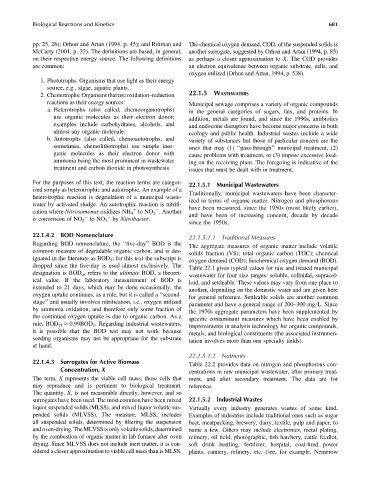Page 726 - Fundamentals of Water Treatment Unit Processes : Physical, Chemical, and Biological
P. 726
Biological Reactions and Kinetics 681
pp. 25, 26); Orhon and Artan (1994, p. 45); and Rittman and The chemical oxygen demand, COD, of the suspended solids is
McCarty (2001, p. 22). The definitions are based, in general, another surrogate, suggested by Orhon and Artan (1994, p. 85)
on their respective energy source. The following definitions as perhaps a closer approximation to X.The CODprovides
are common: an electron equivalence between organic substrate, cells, and
oxygen utilized (Orhon and Artan, 1994, p. 538).
1. Phototrophs: Organisms that use light as their energy
source, e.g., algae, aquatic plants.
2. Chemotrophs: Organisms that use oxidation–reduction 22.1.5 WASTEWATERS
reactions as their energy sources: Municipal sewage comprises a variety of organic compounds
a. Heterotrophs (also called, chemoorganotrophs) in the general categories of sugars, fats, and proteins. In
use organic molecules as their electron donor; addition, metals are found, and since the 1990s, antibiotics
examples include carbohydrates, alcohols, and and endocrine disruptors have become major concerns in both
almost any organic molecule. ecology and public health. Industrial wastes include a wide
b. Autotrophs (also called, chemoautotrophs, and variety of substances but those of particular concern are the
sometimes, chemolithotrophs) use simple inor- ones that may (1) ‘‘pass-through’’ municipal treatment, (2)
ganic molecules as their electron donor with cause problems with treatment, or (3) impose excessive load-
ammonia being the most prominent in wastewater ing on the receiving plant. The foregoing is indicative of the
treatment and carbon dioxide in photosynthesis. issues that must be dealt with in treatment.
For the purposes of this text, the reaction terms are categor- 22.1.5.1 Municipal Wastewaters
ized simply as heterotrophic and autotrophic. An example of a
Traditionally, municipal wastewaters have been character-
heterotrophic reaction is degradation of a municipal waste-
ized in terms of organic matter. Nitrogen and phosphorous
water by activated sludge. An autotrophic reaction is nitrifi-
have been measured, since the 1950s (most likely earlier),
cation where Nitrosomonas oxidizes NH 4 to NO 2 . Another
þ
and have been of increasing concern, decade by decade
is conversion of NO 2 to NO 3 by Nitrobacter.
since the 1950s.
22.1.4.2 BOD Nomenclature 22.1.5.1.1 Traditional Measures
Regarding BOD nomenclature, the ‘‘five-day’’ BOD is the
The aggregate measures of organic matter include volatile
common measure of degradable organic carbon, and is des-
solids fraction (VS); total organic carbon (TOC); chemical
ignated in the literature as BOD 5 ; for this text the subscript is
oxygen demand (COD); biochemical oxygen demand (BOD).
dropped since the five-day is used almost exclusively. The
Table 22.1 gives typical values for raw and treated municipal
designation is BOD u , refers to the ultimate BOD, a theoret-
wastewater for four size ranges: soluble, colloidal, supracol-
ical value. If the laboratory measurement of BOD is
loid, and settleable. These values may vary from one place to
extended to 21 days, which may be done occasionally, the
another, depending on the domestic water and are given here
oxygen uptake continues, as a rule, but it is called a ‘‘second-
for general reference. Settleable solids are another common
stage’’ and usually involves nitrification, i.e., oxygen utilized
parameter and have a general range of 200–300 mg=L. Since
by ammonia oxidation, and therefore only some fraction of
the 1970s aggregate parameters have been supplemented by
the continued oxygen uptake is due to organic carbon. As a
specific contaminant measures which have been enabled by
rule, BOD 21 0.99BOD u . Regarding industrial wastewaters,
improvements in analysis technology for organic compounds,
it is possible that the BOD test may not work because
metals, and biological constituents (the associated instrumen-
seeding organisms may not be appropriate for the substrate
tation involves more than one specialty fields).
at hand.
22.1.5.1.2 Nutrients
22.1.4.3 Surrogates for Active Biomass
Table 22.2 provides data on nitrogen and phosphorous con-
Concentration, X centrations in raw municipal wastewater, after primary treat-
The term, X represents the viable cell mass; those cells that ment, and after secondary treatment. The data are for
may reproduce and is pertinent to biological treatment. reference.
The quantity, X, is not measurable directly, however, and so
surrogates have been used. The most common have been mixed 22.1.5.2 Industrial Wastes
liquor suspended solids (MLSS), and mixed liquor volatile sus- Virtually every industry generates wastes of some kind.
pended solids (MLVSS). The measure, MLSS, includes Examples of industries include traditional ones such as sugar
all suspended solids, determined by filtering the suspension beet, meatpacking, brewery, dairy, textile, pulp and paper, to
and oven-drying.The MLVSS is only volatilesolids, determined name a few. Others may include electronics, metal plating,
by the combustion of organic matter in lab furnace after oven refinery, oil field, photographic, fish hatchery, cattle feedlot,
drying. Since MLVSS does not include inert matter, it is con- soft drink bottling, fertilizer, hospital, coal-fired power
sidered a closer approximation to viable cell mass than is MLSS. plants, cannery, refinery, etc. (see, for example, Nemerow

